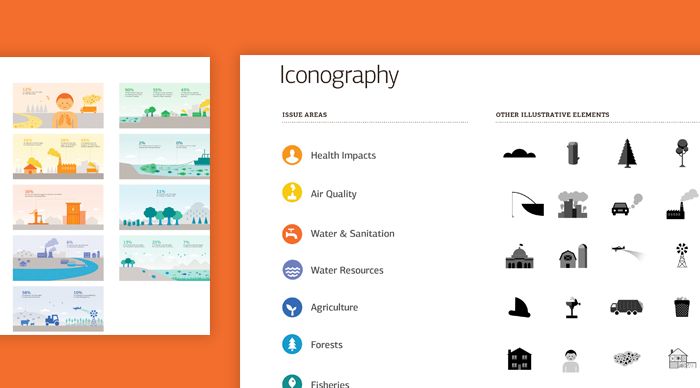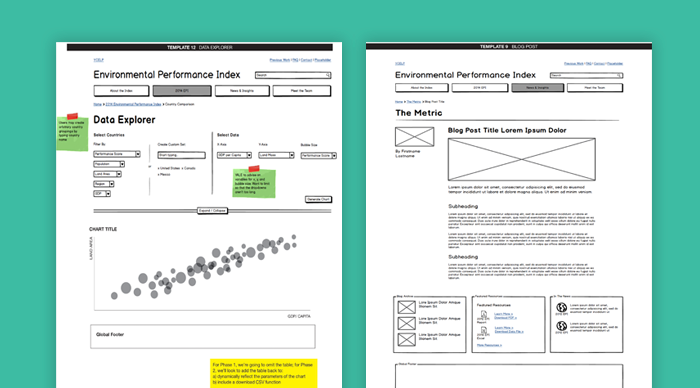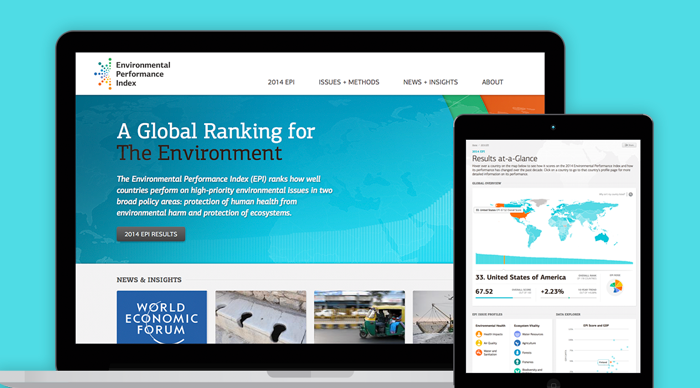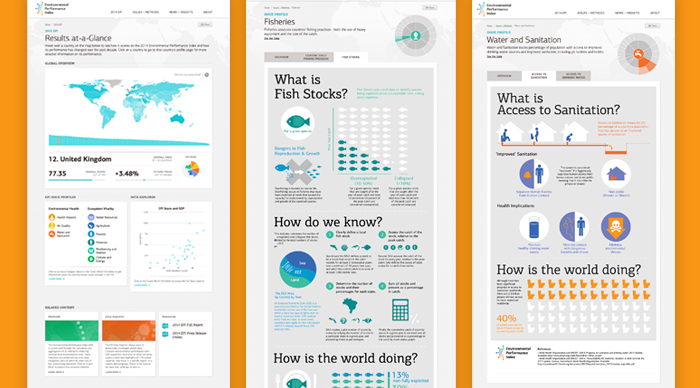When it comes to social impact data visualization design for the environment, the Yale Environmental Performance Index (EPI) sets the standard by which others are measured. A joint effort between two leading university organizations: The Yale Center for Environmental Law & Policy and The Earth Institute at Columbia University, The Yale EPI ranks 180 countries on environmental health and ecosystem vitality—helping scientists, policymakers, and other experts measure how well the world is meeting established environmental policy targets. Looking for new perspective on nonprofit data visualization design, Yale asked Constructive to rebuild the EPI so that its environmental research would be more accessible, engaging, and useful to a wider audience. More than just a wonky, data-rich tool-set for experts, they wanted the new Yale EPI to transform its social index website design into a powerful tool for communicating complex environmental issues—and for accelerating the international movement towards global sustainability.

A Social Index Website Design That Wasn’t Measuring Up
Yale’s Environmental Performance Index is a website built on big data environmental research. Over the years, Yale had designed the social index to be more of a traditional website—a step up from it being purely a collection of big data sets that were made available to environmental scientists. And while it contained all of the data on environmental performance, it was not accessible and failed to engage audiences by making the data come to life.
Confusing navigation and data visualization design made Yale EPI’s key content and insights difficult to find. The social index design lacked infographics that could make its complex research more understandable to a wider audience. And while the Yale EPI website had data visualization tools that allowed users to work with EPI data, functionality was extremely limited. The result was an environmental website design that failed to live up to the quality of its research—and was falling short in inspiring audiences to action.
Applying Best Practices in Data Visualization Design & Data-Driven Storytelling
Digital data visualization websites like the Yale EPI have a big challenge when it comes to generating social impact at a global scale. They need to do more than just share information. If they are to maintain their credibility with research experts, business leaders, and policymakers, social index websites must both maintain an objective, evidence-based approach when making data available and they must also use best practices in data-driven storytelling to inspire greater action so that leaders across the public and private sector use the research to take meaningful action.
In redesigning the Yale EPI, Constructive’s UX design team collaborated with Yale’s research experts to turn their big data, processed in The R Project into a human-centered experience. Together, we developed rapid prototypes using Balsamiq, allowing everyone to see how we could present the EPI’s environmental research in different ways. After weeks of iterating, we designed a data-driven user experience for the social index design that delivers information and the issues from multiple perspectives. The new Yale EPI leads with data, creates context by explaining complex environmental issues, and offers interactive tools to explore the information—elevating ideas and follow throughs with facts to increase understanding and impact.
 Environmental Nonprofit Branding With Rigor and Vitality
Environmental Nonprofit Branding With Rigor and Vitality
While the focus of the Yale EPI is on making data accessible and understandable, we knew that the key to it delivering a strong brand experience required creative thinking and effective design. To differentiate the EPI from other academic exercises in its field, help it connect with a wider audience, and support its data-heavy content, we created a design strategy that’s both emotional and functional. The EPI’s logo is its visual anchor, setting the tone for a comprehensive visual identity system of typefaces, colors, and iconography that gives life to the brand and supports communicating EPI data. The result is a brand experience that creates both a rational and emotional connection with audiences—making it easy and enjoyable for them to engage with the EPI.
Website Design & System Development
Visually, we designed a website that embodies the innovation, integrity, and impact of the Yale EPI. A vibrant user experience pushes the boundaries of traditional academic initiatives— delivering objective, industry-leading research with visual impact. Clean, contemporary design emphasizes usability and legibility; united with an engaging style that maintains focus on the content while inviting audiences to stay a while. The result is an experience that expands the EPI’s influence by reaching beyond a narrow audience of policy wonks and research experts.
Visual Storytelling
Educating lay audiences on complex environmental issues and science is critical to the EPI’s goal of reaching a broader audience of engaged non-experts. We collaborated with Yale to transform the EPI’s research into a high-impact narrative, developing a system of infographics that explain what the EPI tracks, what it means, and most important, why it matters. The result is an unexpected approach to visual storytelling that makes critical environmental issues more accessible by providing memorable takeaways and deepening audiences’ understanding of what’s at stake.
Client’s Take
“We engaged Constructive with the enormous undertaking of rethinking the EPI. They were successful for several reasons: The new website is beautiful, which keeps our users engaged. It’s also highly usable, with tools that give unprecedented access to EPI data. Most important, the infrastructure they built provides a scalable foundation for the years ahead. We couldn’t be happier with the result.” Josh Galperin Associate Director (Former), Yale Center for Environmental Law & Policy.
—————————
If you’d like to explore more of Constructive’s work with climate and environment nonprofits, case studies are available here.







